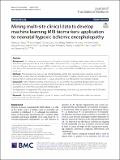Mining multi-site clinical data to develop machine learning MRI biomarkers: application to neonatal hypoxic ischemic encephalopathy
Author(s)
Weiss, Rebecca J; Bates, Sara V; Song, Ya’nan; Zhang, Yue; Herzberg, Emily M; Chen, Yih-Chieh; Gong, Maryann M.; Chien, Isabel; Zhang, Lily; Murphy, Shawn N; Gollub, Randy L; Grant, P. E; Ou, Yangming; ... Show more Show less
Download12967_2019_Article_2119.pdf (1.904Mb)
Publisher with Creative Commons License
Publisher with Creative Commons License
Creative Commons Attribution
Terms of use
Metadata
Show full item recordAbstract
BACKGROUND: Secondary and retrospective use of hospital-hosted clinical data provides a time- and cost-efficient alternative to prospective clinical trials for biomarker development. This study aims to create a retrospective clinical dataset of Magnetic Resonance Images (MRI) and clinical records of neonatal hypoxic ischemic encephalopathy (HIE), from which clinically-relevant analytic algorithms can be developed for MRI-based HIE lesion detection and outcome prediction. METHODS: This retrospective study will use clinical registries and big data informatics tools to build a multi-site dataset that contains structural and diffusion MRI, clinical information including hospital course, short-term outcomes (during infancy), and long-term outcomes (~ 2 years of age) for at least 300 patients from multiple hospitals. DISCUSSION: Within machine learning frameworks, we will test whether the quantified deviation from our recently-developed normative brain atlases can detect abnormal regions and predict outcomes for individual patients as accurately as, or even more accurately, than human experts.
Date issued
2019-11Department
Massachusetts Institute of Technology. Computer Science and Artificial Intelligence LaboratoryJournal
Journal of Translational Medicine
Publisher
BioMed Central
Citation
Weiss, Rebecca J. et al. "Mining multi-site clinical data to develop machine learning MRI biomarkers: application to neonatal hypoxic ischemic encephalopathy." Journal of Translational Medicine 17 (Nov. 2019): no. 385 doi 10.1186/s12967-019-2119-5 ©2019 Author(s)
Version: Final published version
ISSN
1479-5876